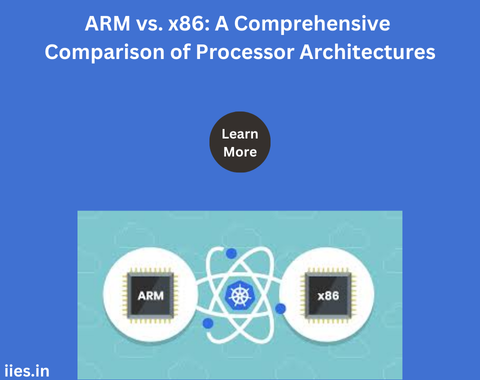1. Understanding Instruction Set Architecture (ISA)
The primary distinction between ARM and x86 lies in their instruction set architectures (ISAs). ARM is built on a Reduced Instruction Set Computer (RISC) architecture, which emphasizes simplicity by utilizing a smaller, more efficient set of instructions. Each instruction in ARM’s ISA is designed to execute in a single clock cycle, minimizing the complexity of each operation. This makes ARM ideal for devices that require energy efficiency and simple, repetitive tasks.
x86, on the other hand, uses a Complex Instruction Set Computer (CISC) architecture, which features a more extensive set of instructions. Some x86 instructions are capable of executing complex operations in a single command, enabling high-performance computing but at the cost of greater power consumption. x86’s complexity allows it to excel in resource-intensive applications, such as running desktop software, gaming, and server-based workloads.
2. Power Efficiency: ARM’s Strength
One of the key factors driving ARM’s dominance in mobile and embedded systems is its superior power efficiency. ARM processors are designed to operate with minimal power, which makes them ideal for battery-powered devices like smartphones, tablets, IoT devices, and even laptops. This energy-efficient design allows ARM to extend battery life while providing sufficient processing power for most user applications.
In contrast, x86 processors, while powerful, are typically more power-hungry. This is due to the increased complexity of the x86 architecture, which results in higher energy consumption during computation. Although Intel and AMD have made strides to reduce power usage with energy-efficient chips like Intel’s Atom and AMD’s Ryzen Mobile, they still can’t match ARM’s efficiency in low-power scenarios.
3. Performance: x86 Leads in Processing Power
While ARM excels in power efficiency, x86 processors traditionally lead in raw performance. The complex instruction set of x86 allows for powerful and fast processing capabilities, especially in applications that require multiple operations per clock cycle. This makes x86 architecture highly suitable for high-performance computing, gaming, and multitasking on desktops and servers.
In recent years, ARM has made significant advancements in performance with chips like Apple’s M1 and M2 processors. These ARM-based processors have shown that ARM can compete with x86 in areas like personal computing, video editing, and productivity applications. Despite ARM’s growing performance capabilities, x86 still holds a competitive edge in areas where maximum processing power is essential, such as 3D rendering, scientific computing, and heavy multi-threaded workloads.
4. Scalability: ARM’s Flexibility Across Platforms
One of the strengths of ARM architecture is its scalability. ARM’s modular design allows it to be used across a wide range of devices, from small embedded systems to powerful servers and supercomputers. This flexibility is why ARM has gained a foothold not only in mobile devices but also in data centers, where energy efficiency is a major concern. The ability to customize ARM chips to meet specific application requirements gives manufacturers like Apple and Qualcomm an edge in designing optimized hardware solutions.
While x86 is dominant in desktops, laptops, and servers, its scalability is more limited compared to ARM. x86 is primarily confined to high-performance computing environments and has been slower to penetrate the mobile and embedded markets. However, x86-based processors continue to excel in personal computers and servers, where their performance and software compatibility are crucial.
5. Market Share and Ecosystem
ARM has emerged as the dominant player in mobile devices, wearables, and embedded systems due to its energy-efficient design. Nearly all smartphones, tablets, and IoT devices use ARM-based processors, with companies like Apple, Qualcomm, and Samsung producing custom ARM chips for their hardware. The extensive ecosystem surrounding ARM includes a wide range of development tools, operating systems, and software optimized for this architecture.
In contrast, x86 continues to dominate the desktop and laptop markets, thanks to its legacy software support and well-established development ecosystem. Intel and AMD are the main suppliers of x86 processors, and the x86 platform is the preferred choice for running Windows-based applications, gaming, and enterprise-level software. The sheer volume of x86-compatible software gives it an advantage in traditional computing environments, though ARM is quickly gaining ground, especially in macOS and Linux-based systems.
6. Software Compatibility: x86’s Longstanding Advantage
x86 architecture has maintained a significant edge in software compatibility, particularly for legacy systems. Over decades, developers have optimized software to run on x86, making it the default choice for many industries that rely on commercial off-the-shelf applications. Most enterprise-level applications, high-performance software suites, and games are optimized for x86 processors.
However, as ARM gains traction in consumer and enterprise markets, more software developers are optimizing their applications for ARM. Apple’s transition to ARM-based chips with its M1 series has led to a surge in ARM-compatible applications for macOS. Additionally, many mobile-first applications, particularly in Android and iOS ecosystems, are built for ARM from the ground up, leading to a growing library of ARM-based software.
7. Emerging Trends: ARM in Data Centers and Beyond
Recent developments in ARM’s performance have led to increased adoption in markets traditionally dominated by x86. ARM-based servers are becoming more common in data centers due to their power efficiency, offering a viable alternative to x86 for certain workloads like cloud computing and large-scale data processing. Companies like Amazon (with its Graviton processors) are beginning to deploy ARM-based solutions to reduce power consumption and costs in their cloud services.
On the other hand, x86 remains a powerful contender in industries requiring heavy computing power, such as video editing, virtual reality, and scientific research. The ongoing competition between Intel, AMD, and ARM ensures that the x86 architecture will continue to evolve, with improvements in power efficiency and performance to meet emerging challenges.

